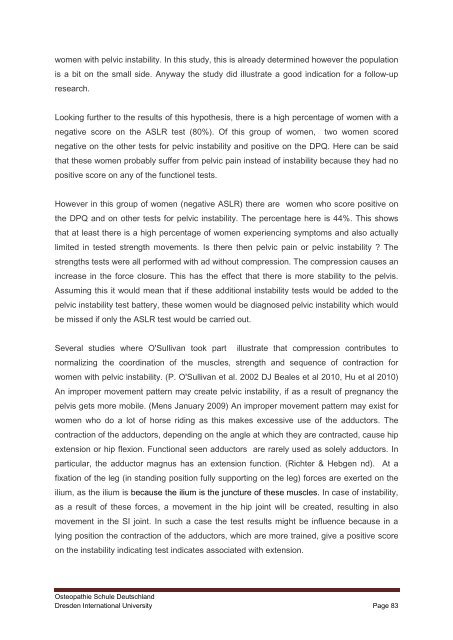Pelvic girdle pain and relevance of ASLR testing: A ... - Cindy Verheul
Pelvic girdle pain and relevance of ASLR testing: A ... - Cindy Verheul
Pelvic girdle pain and relevance of ASLR testing: A ... - Cindy Verheul
You also want an ePaper? Increase the reach of your titles
YUMPU automatically turns print PDFs into web optimized ePapers that Google loves.
women with pelvic instability. In this study, this is already determined however the population<br />
is a bit on the small side. Anyway the study did illustrate a good indication for a follow-up<br />
research.<br />
Looking further to the results <strong>of</strong> this hypothesis, there is a high percentage <strong>of</strong> women with a<br />
negative score on the <strong>ASLR</strong> test (80%). Of this group <strong>of</strong> women, two women scored<br />
negative on the other tests for pelvic instability <strong>and</strong> positive on the DPQ. Here can be said<br />
that these women probably suffer from pelvic <strong>pain</strong> instead <strong>of</strong> instability because they had no<br />
positive score on any <strong>of</strong> the functionel tests.<br />
However in this group <strong>of</strong> women (negative <strong>ASLR</strong>) there are women who score positive on<br />
the DPQ <strong>and</strong> on other tests for pelvic instability. The percentage here is 44%. This shows<br />
that at least there is a high percentage <strong>of</strong> women experiencing symptoms <strong>and</strong> also actually<br />
limited in tested strength movements. Is there then pelvic <strong>pain</strong> or pelvic instability ? The<br />
strengths tests were all performed with ad without compression. The compression causes an<br />
increase in the force closure. This has the effect that there is more stability to the pelvis.<br />
Assuming this it would mean that if these additional instability tests would be added to the<br />
pelvic instability test battery, these women would be diagnosed pelvic instability which would<br />
be missed if only the <strong>ASLR</strong> test would be carried out.<br />
Several studies where O'Sullivan took part illustrate that compression contributes to<br />
normalizing the coordination <strong>of</strong> the muscles, strength <strong>and</strong> sequence <strong>of</strong> contraction for<br />
women with pelvic instability. (P. O'Sullivan et al. 2002 DJ Beales et al 2010, Hu et al 2010)<br />
An improper movement pattern may create pelvic instability, if as a result <strong>of</strong> pregnancy the<br />
pelvis gets more mobile. (Mens January 2009) An improper movement pattern may exist for<br />
women who do a lot <strong>of</strong> horse riding as this makes excessive use <strong>of</strong> the adductors. The<br />
contraction <strong>of</strong> the adductors, depending on the angle at which they are contracted, cause hip<br />
extension or hip flexion. Functional seen adductors are rarely used as solely adductors. In<br />
particular, the adductor magnus has an extension function. (Richter & Hebgen nd). At a<br />
fixation <strong>of</strong> the leg (in st<strong>and</strong>ing position fully supporting on the leg) forces are exerted on the<br />
ilium, as the ilium is because the ilium is the juncture <strong>of</strong> these muscles. In case <strong>of</strong> instability,<br />
as a result <strong>of</strong> these forces, a movement in the hip joint will be created, resulting in also<br />
movement in the SI joint. In such a case the test results might be influence because in a<br />
lying position the contraction <strong>of</strong> the adductors, which are more trained, give a positive score<br />
on the instability indicating test indicates associated with extension.<br />
Osteopathie Schule Deutschl<strong>and</strong><br />
Dresden International University Page 83


